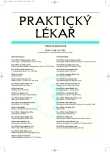Diabetic foot syndrome
Syndrom diabetické nohy
Syndrom diabetické nohy s defektem se objeví až u 15–20 % diabetiků v průběhu jejich života. Jedná se o častý, ale mnohdy zanedbávaný problém. Etiologie diabetické ulcerace je spojena zejména s neuropatií a ischémií dolních končetin, na jejímž vzniku se často podílí trauma. Infekce prodlužuje a někdy i znemožňuje hojení diabetické rány, významně zvyšuje riziko amputací. Důsledkem neuropatie je i Charcotova osteoartropatie, která vede často ke vzniku ulcerací. Časnou terapií této nemoci v akutní fázi se dá předejít vzniku deformit a jejich komplikacím. Riziko vzniku syndromu diabetické nohy roste s věkem, komorbiditami, délkou trvání diabetu. Komplexní léčba syndromu diabetické nohy musí zahrnovat řešení všech rizikových faktorů – ischémie, tlaku na ulceraci, infekce, metabolické kompenzace. Lokální léčba znamená debridement (odstranění nekróz), použití lokálních prostředků podporujících granulaci a epitelizaci rány, a pak i ochranu nově vzniklé jizvy před recidivou defektu. Důležitou roli v terapii má chirurgická léčba. Kromě účinného debridementu a preventivních operací má za úkol provést v indikovaných případech nezbytně nutné amputační výkony ve snaze zachovat co nejlépe funkčnost končetiny. Primární prevence vzniku nových ulcerací a sekundární prevence vzniku reulcerací sehrává klíčové postavení při redukci počtu nemocných se syndromem diabetické nohy.
Klíčová slova:
syndrom diabetické nohy, diabetická ulcerace.
Authors:
J. Pástorová 1; Kusalovám. 1; L. Prokeš 2; L. Sobotka 1; A. Šmahelová 1; L. Voráčková 1; J. Stárková 1
Authors‘ workplace:
Klinika gerontologická a metabolická
Přednosta: prof. MUDr. Luboš Sobotka, CSc.
1; Ortopedická klinika
Přednosta: doc. MUDr. Karel Karpaš, CSc.
Fakultní nemocnice Hradec Králové
Ředitel: doc. MUDr. Leoš Heger, CSc.
2
Published in:
Prakt. Lék. 2007; 87(2): 92-96
Category:
Of different specialties
Overview
A diabetic foot ulcer appears in 15-20 % of diabetics in their lifetime. It is a very frequent, but often neglected problem. The aetiology of a diabetic ulcer is particularly associated with neuropathy and ischaemia of the lower limb, most often induced by a trauma. Infectious complication prolongs or arrests the healing process, significantly increasing the risk of amputation. Charcot arthropathy very often leads to the foot ulcer, it is one of the consequences of neuropathy. Early diagnosis and treatment of Charcot arthropathy in the acute phase of disease may prevent deformity and its complications. The risk of diabetic foot syndrome increases with age, comorbidities, and duration of diabetes. Complex therapy of diabetic foot syndrome includes treatment of all risk factors such as ischaemia, infection, pressure on ulceration, metabolic compensation. Local therapy implies debridement (necrectomy), using a new local treatment, which encourages granulation and epithelisation, and then protecting the newly created scar against trauma. Surgical treatment represents an important role in the therapy. There are a host of surgical procedures – preventive operations, effective debridement, and resecting infected bone. The most important is essential amputation in indicated cases. There is a tendency to minimize amputations and protect the structure and the function of the foot. Primary prevention of diabetic ulcers and secondary prevention of reulceration play key roles in reducing the number of patients with diabetic foot syndrome.
Key words:
diabetic foot syndrome, diabetic ulcers
Labels
General practitioner for children and adolescents General practitioner for adultsArticle was published in
General Practitioner

2007 Issue 2
- Hope Awakens with Early Diagnosis of Parkinson's Disease Based on Skin Odor
- Advances in the Treatment of Myasthenia Gravis on the Horizon
- Memantine Eases Daily Life for Patients and Caregivers
- Metamizole at a Glance and in Practice – Effective Non-Opioid Analgesic for All Ages
- Memantine in Dementia Therapy – Current Findings and Possible Future Applications
Most read in this issue
- Risk of malnutrition and nutritional support in Alzheimer disease
- Active search for prostate cancer by PSA testing in GP surgery
- The legacy of I. F. Semmelweis; key milestones in the development of hospital hygiene and current challenges.
- Symptomatic diabetic neuropathy: irreversible nerve damage?
